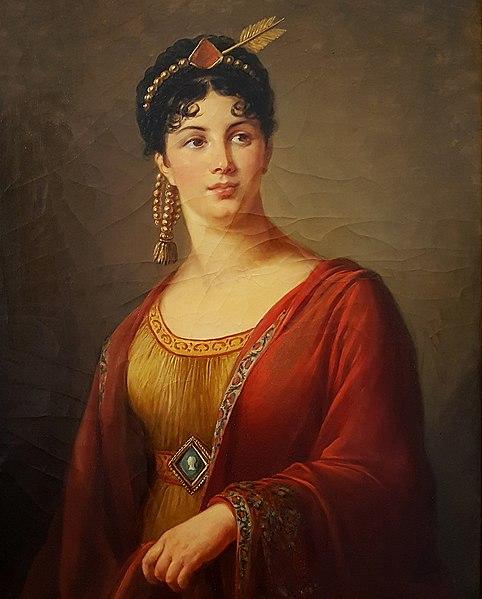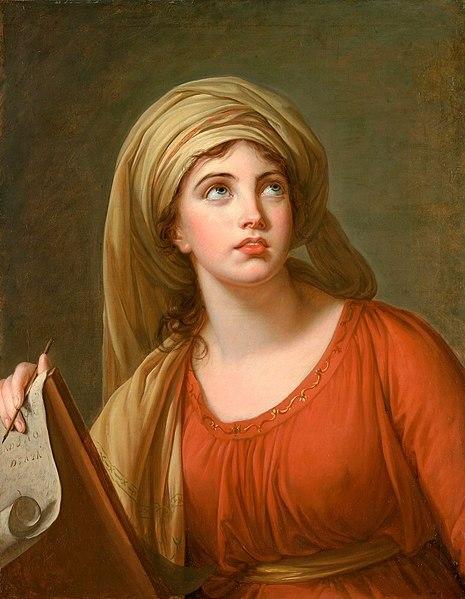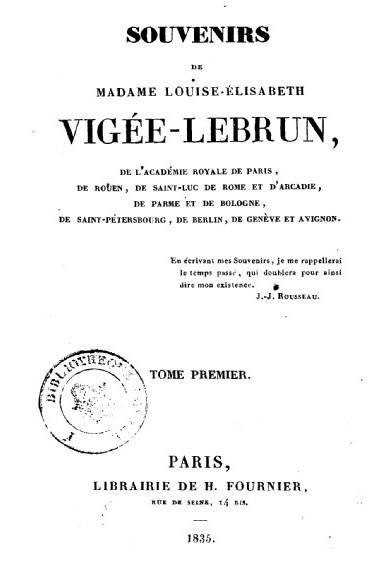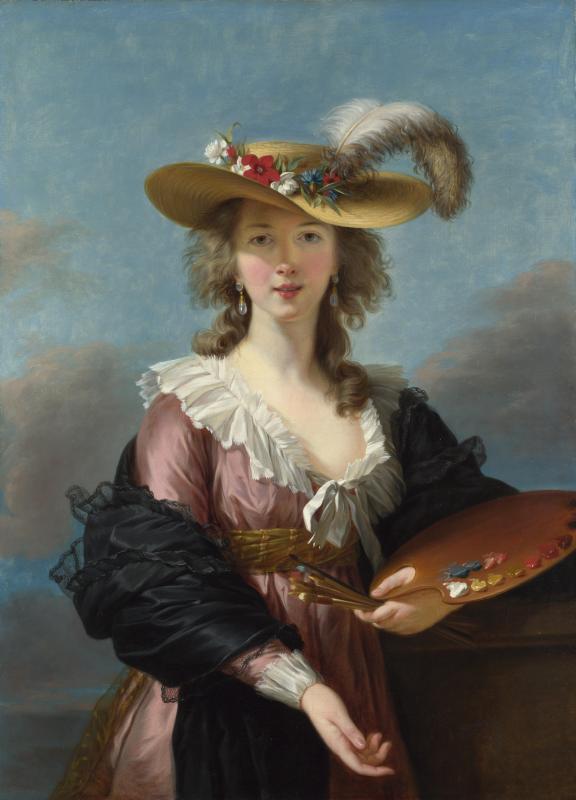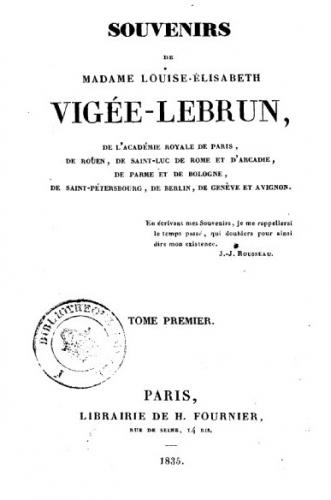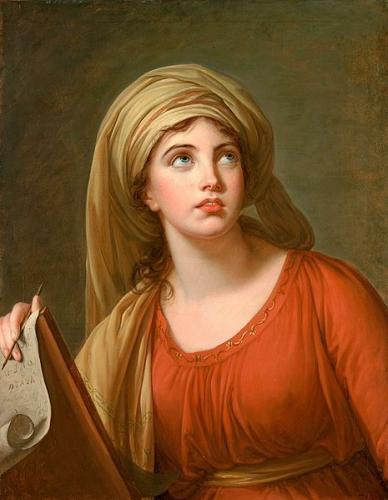Abstract
Élisabeth Vigée Le Brun was the official portraitist of Marie-Antoinette and a worldly artist who excelled at constructing representations of herself and of others. In October 1789, she emigrated to Italy, then over the next twenty years, criss-crossed the continent from Rome to Saint Petersburg, ending with a sojourn in England. Between 1835 and 1837, she published her Souvenirs, weaving artistic sociability into her chronicles of the lives of the European elite. This article discusses the many relationships Vigée Le Brun developed with Britons and British expatriates, as well as the opinions on British social practices she revealed in her autobiography.
Élisabeth Vigée Le Brun (1755–1842) was the daughter of Louis Vigée, a pastellist, and the elder sister of Étienne Louis Jean-Baptiste, an ambitious writer. It was her loving father who introduced her to painting, and not long after his premature death, on Joseph Vernet’s counsel, Vigée Le Brun embarked on a career as a portraitist. Though still quite young, she conquered Paris, her skill and charm propelling her into the limelight of worldly sociability. In 1776, she wed Jean-Baptiste Pierre Le Brun, a talentless artist but skilled paintings and antiquities dealer, who encouraged her artistic endeavours. Though they would divorce in 1794, and despite the events surrounding the Revolution,1 Le Brun remained her fervent defender, though a somewhat ambiguous business ally. Their union marked the first step of her vertiginous rise in social status from a bourgeois woman of artistic origins to an intimate of the queen and France’s elite.2 In the early 1780s, French fashion continued to run towards novelty and elegance, but there was a burgeoning desire for sartorial freedom and sobriety.3 Vigée Le Brun’s portraits of the queen and of Yolande de Polignac contributed to the fashion for the white chemise gown in Europe.
- 1. Jean-Baptiste Le Brun, Précis historique de la vie de la citoyenne Lebrun (À Paris, chez l’auteur, An II).
- 2. See Mary D. Sheriff, The Exceptional Woman. Elisabeth Vigée-Lebrun and the Cultural Politics of Art (Chicago and London: Chicago University Press, 1996).
- 3. Portraiture and fashion reciprocally influenced the other. See À la mode. L’art de paraître au XVIIIe siècle, L’Objet d’art. Hors-Série (Dijon : Éditions Faton, 2021).
Vigée Le Brun’s alliances with the royal court and the Polignac family made her a target for slander in revolutionary libelles, forcing her to flee at the first stirrings of the Revolution. Her peregrinations took her around Europe, ending only some sixteen years later when she made her way back to France. From 1789 to 1805, throughout the long years of her exile, she crossed paths with dozens of British subjects. After meandering through the continent, she journeyed to London, staying nearly three years, with occasional trips to thermal spas and the country homes of the British aristocracy. Her encounters provided her with the opportunity to both pen and paint a series of striking portraits. Later in life, as she fretted over how posterity would remember her, she composed her own life story, sifting through her extraordinary personal trajectory, reconstructing her existence as a worldly woman and an artist who, armed only with her paintbrush, her daughter Julie by her side, criss-crossed all of Europe and into Russia. Between 1835 and 1837, she published her Souvenirs,4 three volumes interspersed with letters, reminiscences, stories of her travels, and a list of her paintings.
- 4. Élisabeth Vigée Le Brun, Souvenirs. 1755-1842, ed. Geneviève Haroche-Bouzinac (Paris : Classiques Champion, 2015).
Though she had frequented few Britons while living in Paris, this changed once she crossed the Alps. Italy was a key stop on the Grand Tour and a highly popular destination for British nationals; artists and art aficionados from all over Europe trekked through the mosaic of independent city-states that dotted the Italian peninsula. The British excelled at portraiture and were avid collectors of portraits. Consequently, they took a keen interest in Vigée Le Brun as one of the very few women to have been honoured by the Royal Academy of Painting in Paris.
Towards the end of 1789, on Vigée Le Brun’s first stay in Rome, she met frequently with Angelica Kauffmann, a Swiss painter and one of the founding members of London’s Royal Academy. Kauffmann’s skill as a portraitist was highly prized in British high society. Vigée Le Brun took great pleasure in calling on her Swiss counterpart, whom she considered ‘one of the glories of our sex’ (Souvenirs, 358). She enjoyed being seen with Kauffmann at the opera and finding herself seated beside the artist at official receptions. Although she socialised with other French émigrés while in Rome, she mainly rubbed shoulders with Grand Tourists, painting portraits of Anne Pitt, Lord Camelfort’s daughter, Hyacinthe Roland, the future wife of Lord Wellesley, and Lord Bristol. ‘The English on holiday in Rome represented an appreciable network of clients’5 for one who needed to ‘remake her fortune’ (372). Vigée Le Brun gladly welcomed the many visitors who invaded her apartments each morning to view the self-portrait she intended to submit to the Florence Academy, as they were instrumental in establishing her notoriety in Italy.
- 5. Geneviève Haroche-Bouzinac, L. E. Vigée Le Brun. Histoire d’un regard (Paris : Flammarion, 2011), p. 215.
Yet it was during her six-month stay in Naples that Vigée Le Brun finally triumphed with a series of portraits Lord Hamilton, the British ambassador, had commissioned of his beloved Emma Hart (née Lyon). The future Lady Hamilton, whose physique evoked that of ancient Greek statues, had previously posed for the likes of Romney, Reynolds and Kauffmann. Even so, Vigée Le Brun regarded her young model with a touch of class condescension, finding her vulgar, uneducated and disdainful. In her Souvenirs (written and published long after Hart’s death), she claims6 to have counselled Hart on how to dress (in white tunics and coiffed in a schall)7 and taught her to strike dramatic poses (she was well noted by contemporaries for her ability to spontaneously change her expression and adopt an array of guises).8 Following the trend of allegorical portraiture that was fashionable in England at the time, Vigée Le Brun first represented Hart as a Bacchante (reclined, then dancing with a drum) and in 1792 as a Sibyl. The artist was strongly attached to this last painting, and it would remain one of her ‘favourite works’ (440). She continued to exhibit it on important stops in her long travels throughout Europe, and upon her return to Paris in 1805, gave it a prominent place in her studio.9 In Naples, Lord Hamilton received Vigée Le Brun in his various residences, including one with a view of Mount Vesuvius and its volcanic activity. She took part in various excursions, delighting in the luminosity and landscapes she discovered and the popular celebrations she found so picturesque. Ever the fashionable lady, yet with an eye to simplicity and practicality, she began sporting a green veil to protect her eyes from the blazing Neapolitan sun, setting the fashion for the English women on holiday (416). In 1792, while in Turin, she learned of the September Massacres in the prisons. Her intention had been to return to France, but as the new wave of French émigrés began to surge through Italy, she turned eastward to Vienna, making her way to Berlin and then onto Saint Petersburg, where she had little contact with British nationals.
- 6. Goethe describes Hart’s use of shawls in a 1787 account, in plain contradiction to Vigée Le Brun’s claim. See Ersy Contogouris, ‘Inspiration divine : Lady Hamilton en sibylle par E. Vigée-Le Brun’, RACAR : Revue d'art canadienne / Canadian Art Review (vol. 35, n° 2, 2010), p. 36.
- 7. Vigée Le Brun, an arbiter of fashion, drew from her artist’s wardrobe for the costumes and accessories to dress her models in. Such elements are characteristic of her pictorial style and can be seen in many of her paintings. (À la Mode […], 7)
- 8. See, for example, Adèle de Boigne, Mémoires [1907] (Paris : Mercure de France, 1971), rev. ed. 1999, vol. 1, p. 122-23.
- 9. She finally sold it in 1819 to the duc de Berry.
In 1800, Vigée Le Brun’s name was finally struck from the list of emigrants, and on January 18, 1802, she returned to Paris. But she no longer recognised her beloved city, especially considering how much sociability practices had changed. The men’s shimmering habits had given way to black redingotes and the dinner parties she remembered had practically disappeared. Following English proprieties, the women were segregated from the men during musical evenings, and the Napoleonic court, highly militarised and made up in large part of parvenus, seemed to lack elegance and refinement. Vigée Le Brun began to formulate a plan to cross the English Channel and discover the country whose many expatriates she had met and painted during her years in exile. Towards the end of the summer, Benjamin West, a history painter and then president of the Royal Academy of Arts, organised a meal for his Parisian colleagues. At the party, Vigée Le Brun was introduced to Joseph Farington,10 a painter, who immediately fell under her charm, Helen Maria Williams, a writer and salonnière who frequently had her brother Étienne recite her poems, John Kemble, an actor, and prominent members of the English nobility who shared a deep interest in the arts, such as Lady Oxford. Commissions had been few and far between in Paris. The Franco-British luncheon convinced Vigée Le Brun to leave the city for greener pastures (Haroche-Bouzinac 393-394).
- 10. The Farington Diary (London: Hutchinson and Co., 1923), vol. 2, p. 35.
On April 15, 1803, without knowing a word of English, she set sail from Calais, her faithful servant Adélaïde at her side. If she had hoped that her fortunes would improve in London, what she found there failed to ignite her enthusiasm. There were no paintings museums – the National Gallery would not open its doors until 1824 – and though Westminster Abbey and St Paul’s Cathedral contained a wealth of treasures, they did not satiate her curiosity as much as the Parisian and Italian collections had. She did enjoy receiving Sarah Siddons, an actress whose performances she admired (662), but lamented that Sundays in London ‘were as sad as the climate’ (659) and as great a source of ennui for her as they were of amusement for others. On Sundays, shops were closed and there were no plays, balls, or concerts, her favourite form of entertainment. She was forced to take refuge in routs, great assemblies where hundreds of guests crowded in so thickly it was impossible to come within reach of the lord or lady of the house. ‘In this throng’, she wrote, ‘one is unendingly squeezed, jostled and elbowed, to the point where one grows utterly weary, and yet there is nowhere to sit’ (659). Compounding her misery was the lack of conversation, both at routs and during walks in the city parks where, she described, couples strolled about like ‘meandering shadows’ (ibid.).
She pined for the salons of the Ancien Régime and for the popular soirées she had hosted, such as her famous ‘souper grec’ in January 1788, or the farewell ball in March 1803. The lively, vivacious Vigée Le Brun could not see herself in the worldly London gatherings where restraint was imposed and where she often found conversation lethargic. Yet she needed to expand her network of clients, and the community of French émigrés gathered around the Orléans, the comte de Vaudreuil and the comte d’Artois were not enough to sustain her in her trade. It was therefore during the London routs that she ‘composed her society’, though she received no portrait commissions from the ladies she met there, such as Lady Hertford, Lady Monck, and the Duchess of Devonshire, Georgiana Cavendish, who was ‘at the time, the most fashionable woman in London’ (664).11 Eager to become part of the whirligig of invitation exchanges, she hosted evenings (663) during which music was prominently featured, including performances from the two prima donnas of the Opera, Elizabeth Billington and Giuseppina Grassini, and the famous violinist Giovanni Battista Viotti, a favourite in both Paris and London. Her concerts attracted the cream of society, not least the extravagant and inconstant Prince of Wales, whose portrait she would paint in 1803. It was thanks to the prince’s favour that she was able to remain in Britain despite the breakdown of the Treaty of Amiens. But that same benevolence earned her the enmity of others (668). Unlike Joshua Reynolds, who had enthused over her portrait of the comte de Calonne during her passage through London customs (661), some of her British peers were less appreciative of her talent. In 1805, John Hoppner, one of Vigée Le Brun’s rivals, published a pamphlet on her as a preface to his Oriental Tales. She found particularly hurtful Hoppner’s accusation that she had transformed her workshop into a draper’s shop, especially in light of the fact that English painters charged a gratuity for visits to their workshops, a practice she found detestable. The money was ostensibly reserved for the servants but was, in fact, quickly pocketed by their masters (661).
- 11. Amanda Foreman recounts in her biography of Georgiana Cavendish that the elegant duchess introduced the British to the light muslin dress à la Créole in which Vigée Le Brun had painted Marie-Antoinette in 1783, and that it was an immediate success. See Amanda Foreman, Georgiana. Duchess of Devonshire (New York: Harper Collins, 1999), p. 176.
London was not the only venue for receiving guests during George III’s reign. The lively, mondaine society life Vigée Le Brun so prized also unfolded in the ‘country houses’ that ‘dotted the beautiful English countryside’ (675) and were an essential thread in the social fabric. Weary of London fog, thick with the coal smoke that ‘dulled the imagination’ (679), she seized every opportunity to flee the city. She found refuge in Gillwell, at the country home of Margaret Chinnery, whose friend and correspondent, Madame de Genlis, Vigée Le Brun had painted;12 and again in Blenheim, with the eccentric margravine d’Anspach, Elizabeth Craven (née Berkeley). She browsed the art collections housed in sumptuous residences, such as Hampton Court, where she admired Raphael’s cartoons, Knowles Castle, then owned by the Duchess of Dorset, Stowe, the country seat of the Buckinghams, Blenheim, with the Marlboroughs, and Warwick, where to her dismay, she found two of the drawings she had offered to Lord Hamilton. She basked in the frank cordiality of astronomer William Herschel, who graciously showed her his inventions (his famous telescope), discoveries (the planet Uranus) and maps of the moon. In Herschel’s company, ‘not one moment was spent in ennui’ (677).
- 12. The Unpublished Correspondence of Mme de Genlis and Margaret Chinnery, ed. Denise Yim (Oxford: Voltaire Foundation, SVEC, 2003).
She stayed in some of Britain’s most celebrated spa resorts, admiring the landscapes of Matlock, in Derbyshire, and Tunbridge Wells, in Kent. She found Brighton ‘lovely’ (678) and Bath ‘noble and picturesque’ (679). But for all that, her writings once again leave us with the impression of a woman genuinely perplexed by the charms of English sociability. We learn in a letter to her brother that at Tunbridge Wells, ‘the innumerable evening assemblies were tremendously tedious’ (678). As for Bath, she wrote, ‘I stayed three weeks in Bath. I had been given so many assurances I would thoroughly enjoy myself there, that I expected to find the delights of Capua. Would that I had’ (680). Despite it all, Vigée Le Brun built a close circle of friends in Britain, including Lady Bentinck, Mrs Anderson and Lord Trimlestown, and regretted leaving them behind (690) when she rejoined her daughter in Paris. In her final travels abroad to Switzerland, in 1807 and 1808, she was received by Germaine de Staël, among others, but found no further opportunities to associate with Britons. She would not return to England.
Over the course of her exile, Élisabeth Vigée Le Brun did find echoes of Ancien Régime sociability in the courts of Europe – Vienna and Saint Petersburg especially – and of the scintillating soirées she had so expertly hosted in France. But in her Souvenirs, those nights contrasted all the more sharply with the practices – too bourgeois, too austere, too Protestant – of England. One of her principal criticisms concerned the differences between male and female evening activities: ‘After dinner, we gathered in a beautiful chamber. The women would sit at one end, silently toiling away at their embroideries and needlepoint. The men read books at the other end, keeping the same silence’ (685). The ‘absolute dearth of conversation’ in the evenings weighed heavily on Vigée Le Brun. Oddly enough, she had found there were ‘plenty of brilliantly witty Britons’ with whom it was quite possible to ‘have delightful conversations.’ Her lengthy – and relatively lucrative – sojourn in England had otherwise led her to challenge the widespread preconception about the lack of hospitality in the British Isles (690).
Her friendships with Britons do not seem to have been as deep as those she formed with other foreign nationals, namely Princess Kurakina and Countess Potocka, to whom she dedicated the two main epistolary sections of her Souvenirs.13 Nevertheless, she remained strongly attached to her portrait of Lady Hamilton as a Sibyl.14 According to accounts from a number of foreign visitors,15 including Bertie Greatheed16 (1803) and Maria Edgeworth (1820),17 she exhibited the portrait in her Parisian studio throughout the Consulate and into the Restoration. The bonds of sociability she forged with the British world lasted far beyond her stay. After Jacques-Louis David, Vigée Le Brun was the artist English visitors most called on in Paris.18
- 13. Volume 1 is entitled ’Lettres à la princesse Kourakine' (Letters to Princess Kurakina). The section in volume 3 on her travels in Switzerland, ‘Voyage en Suisse en 1808 et 1809’, consists of letters addressed to Countess Potocka.
- 14. Contogouris posits that Vigée Le Brun kept the painting as a sort of manifesto on female genius, implicitly projecting her own identity onto the portrait. Op. cit., p. 41-43.
- 15. See for example Johann Friedrich Reichardt, Un hiver à Paris sous le Consulat. 1802-1803 [Vertraute Briefe aus Paris], trans. Arthur Laquiante, rev. Charles Mehl, ed. Thierry Lentz (Paris : Taillandier, 2003), p. 181-83.
- 16. An Englishman in Paris: 1803. The Journal of Bertie Greatheed, eds J.P.T. Bury and J.C. Barry (London, 1953), p. 26-32.
- 17. ‘Maria Edgeworth to Mary and Charlotte Sneyd, 7 July 1820’, Maria Edgeworth in France and Switzerland. Selections from the Edgeworth family letters, ed. Christina Colvin (Oxford: Clarendon Press, 1979), p. 181.
- 18. See Henri Fauville, La France de Bonaparte vue par les visiteurs anglais (Aix-en-Provence : Edisud, 1989).
Share
Further Reading
Baillio, Joseph, and Salmon, Xavier (eds.), Élisabeth Louise Vigée Le Brun (Paris : Réunion des Musées Nationaux/Grand Palais, 2015).
Contogouris, Ersy, Emma Hamilton and Late Eighteenth-Century European Art: Agency, Performance and Representation (New York/London: Routledge, 2018).
Fumaroli, Marc, Mundus Muliebris. Élisabeth Louise Vigée Le Brun, peintre de l’Ancien Régime féminin(Paris : Éditions de Fallois, 2015).
May, Gita, Élisabeth Vigée Le Brun. The Odyssey of an Artist in an Age of Revolution (New Haven & London: Yale University Press, 2004).
Pitt-Rivers, Françoise, Madame Vigée Le Brun (Paris : Gallimard, 2001).
Sheriff, Mary D., ‘Portrait de l’artiste en historienne de l’art : à propos des Souvenirs de Mme Vigée-Lebrun’, in Mechthild Fend, Melyssa Hyde and Anne Lafont (eds.), Plumes et pinceaux : discours de femmes sur l’art en Europe (1750-1850). Essais (Paris : Publications de l’Institut National d’Histoire de l’Art, 2012).
